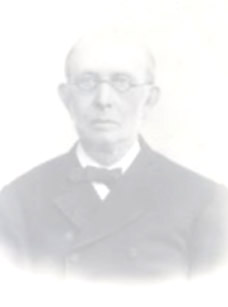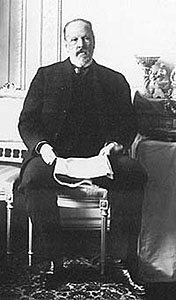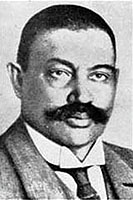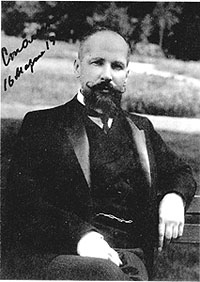There are many ways to approach a
study of the last twenty-five years of imperial Russia and the reigns
of Alexander III and Nicholas II. What I am going to do is offer
some remarks by looking at two of the main struggles that took place
between competing visions of Russia's future, and I am going to
personify those struggles in terms of first Konstantin Pobedonostsev
(1827-1907) versus Sergei Witte (1849-1915) and then followed by Evno
Azef (1869-1918) versus Petr Stolypin (1862-1911). These were men
and issues that determined Russia's fate.
I also have some separate notes on Aleksandr III and Nikolai II.


These two men were similar is some very striking ways.
- Both were well-educated
- They tended to move outside of court circles
- The assassination of Alexander II influenced both men
- Both kind of just drifted out of official state offices after the 1905 Revolution which essentially challenged both of their policies.
- Each experienced a reversal of their early ideological orientations; Witte from a believer in Slavophile ideas to a convinced modernizer along European terms; Pobedonostsev from a scholarly and legal career into a champion of conservative politics.
In terms of official rank,
these were probably two of the most important statesmen of imperial
Russia. Pobedonostsev was Ober Procurator of the Holy Synod from
1880 to 1905, which meant that he was the chief state official in
charge of all Russian Orthodox Church affairs. He was also tutor to
both Alexander III and Nicholas II. Witte was Minister of Finance
from 1892 to 1903, Chair of the Committee of Ministers from 1903 to 1905 and
then Prime Minister from 1905 to 1906.
Their visions for Russia could not have been more different than night and day.
Pobedonostsev,
nicknamed the "grey
eminence," was a through and through, devout conservative and convinced
supporter of "autocracy, orthodoxy and nationality " (Official
Nationality). Not unusual for nineteenth-century conservatives,
he felt that man was inherently sinful and needed the strong reigns of
tsar and
church to keep order. In his book, Reflections of a Russian
statesmen,
he denounced
almost everything there was about constitutional or
parliamentary systems, natural rights or freedoms and democracy.
Pobedonostsev felt that the people needed to maintain their respect for
the traditional institutions of Russia. Any attempt to
reform society was evil; one must, above all, preserve the autocracy intact and support the national church.
Pobedonostsev exercised considerable influence on the policies of Alexander III (a bit less so on Nicholas II), for example, by encouraging an official policy of Russification directed against the minority populations of the empire. He also worked to bring primary education under control of the church. He has usually been considered the author of the tsar's "senseless dreams" speech of 1895 when Nicholas II stated that any persons thinking about an enlarged role for zemstvos in the government, or even an expanded degree of public representation, were just having "senseless dreams." Pobedonostsev also was influential in supporting programs of religious persecution largely directed against Jews.
It is hard to determine just how much influence Pobedonostsev actually ever wielded, but it had decreased substantially by the time of the Russo-Japanese War and then the 1905 Revolution. But the ideology, which he symbolized, still found a lot of support in Russia.
Witte
made his name working on the
railroad, figuratively speaking. He actually did work in a number
of railroad posts
until in 1887 he became director of the state railways in the ministry
of finance (later promoted to Minister of Finance). There he developed the
"Witte system," a program of heavy industrialization, focusing on railway
construction--of course--that was designed to allow Russia to catch up with the
more advanced western countries in a decade or so and also allow Russian
exports to reach markets in the Near and Far East. Witte was
the first to imagine (and then carry out) the
use of massive state intervention in the economy to develop a national
economy. Above all, he wanted to bring Russia up to
European living standards. Under Witte, Russia did
experience sustained
economic growth rates that improved living standards for the Russian
people. He was never able to undertake an agrarian reform that
would have complemented what he had undertaken in industry and finance
(such as the gold standard 1897).
Witte's
focus on industry, his success in negotiating an end to the
Russo-Japanese War and his work in crafting an end to the disturbances
of 1905 and the creation of a semi-parliamentary regime in Russia made
Witte's rivals incredibly jealous, including the tsar, and he was dismissed
from power. But his vision was one of Russia as a modernized country equal to any of its contemporaries in Europe.
So, round one, in the struggle to define Russia's direction was between conservative
stability (maintain Russia's natural institutions) and massive change (introduce
European institutions). The conclusion of this struggle played out between 1904
and 1905,
but the outcome pleased no one and solved none of Russia's
essential problems. Witte had to put on hold his ideas of
agrarian reform, and though some European political and economic forms
appeared in Russia, they were never really embraced by enough of the
Russian population. Conservative forces struggled to maintain
order, but that was not going to work either as too many changes had
occurred; there were now large, industrial cities with a working class
and also a middle class. That could not be fit into the
conservative vision of Russia, but that was not going to disappear.
Russia was like a car
being driven down a road by a drunken driver, careening down the road, veering wildly from
one lane to the other, smashing off guard rails on either side, just narrowly missing trees and oncoming traffic.


After 1905, the struggle shifted onto new ground; here symbolized by the terrorist Azef and the Russian prime minister Stolypin. Not many similarities here.
Azef, one-time journalist, salesman, thief, student, engineer, etc., was, in theory, a member-in-good-standing of the Russian socialist revolutionary party. In 1903 he became director of the party's Battle Organization and helped carry out the assassinations of prominent government figures such as the Minister of the Interior, Viacheslav Plehve in 1904 and then the tsar's uncle, the Grand Duke Sergei Alexandrovich in 1905, and Father Gapon in 1906. On the other hand, Azef was on the payroll of the Okhrana, the tsarist secret police and a key informer. Unbelievable! Unclear which side got the better deal. (Only in 1908 was Azef finally un-masked as a police agent.)
But Azef symbolizes the clear turn by Russian radicals to
terror as an instrument to achieve revolution, and the use of terror
reached unbelievable
dimensions between 1906-1911. True, there were some lulls in its
intensity,
but then another spate of assassinations would occur. Radicals
were no longer confident that the government or peaceful/legal means
could move Russia in the direction of reform. These
revolutionaries now advocated a radical and complete overthrow of much
of the existing order in Russia and the realization of a socialist
future for the country. The terrorists disdained any governmental
half-measures and wanted Russia to move forward fast to that radical
future.
Petr Stolypin, Chairman of the Council of Ministers, i.e., prime
minister, from 1906 until 1911, was born into high society, from a
solidly noble family and spent much of his early life immersed
in provincial public life in the northwestern provinces of the
empire. This experience gave him a good understanding of
nationalities issues in Russia and also of the problems that peasants
faced. (The Russian economy was still overwhelmingly agricultural
despite the industrialization carried out by Witte.) Stolypin
rose slowly through government ranks until he was appointed prime minister after the First Duma was dissolved in April 1906.
Ok,
so what was Stolypin's
vision of Russia. Part 1 was to restore and then maintain order
in the face of public disorder and assassinations. He instituted
military, field court martials to deal with the terror; trial one day,
hanging the next. Thousands died, and the gallows were popularly
called "Stolypin neckties." But Stolypin was not going to give
into terror. Part 2 was to get the parliamentary institutions,
i.e., the Duma, working in a partnership with the government. To
that end, he "masterminded" the alleged coup d'état of 3 June
1907 when
the tsar dissolved the Second Duma and then issued a new electoral law,
which effectively disenfranchised most of the Russian population.
This provided a more balanced (read "conservative") Duma that was
supposed to cooperate in Stolypin's reform process. (The change
in the electoral law was illegal; that is why it is often labeled a
coup.) Part 3 was a massive, and far-ranging land reform carried
out by imperial decree (Later the Duma
finally approved.). The reform intended to break up the village
land commune, a system in which the commune owned the land and
parceled out strips of land to individual families to farm
(extraordinarily inefficient). Individual peasants would be able
to withdraw from the commune and consolidate their holdings into a
single, compact farm. Stolypin hoped that this would increase
agricultural productivity and also give peasants a better stake in the
economy. Funds were to be provided to peasants, and peasants were
also encouraged to migrate to Siberia in search of better land.
This was popularly called Stolypin's "Wager on the Strong," but it was
not only aimed at the "strong" and wealthy. Finally, there is
some evidence that Stolypin was preparing further administrative and
organizational reforms before his untimely death.
In some respects, Stolypin symbolizes the continued effort by reform-minded individuals to move Russia in the direction of Europe, i.e., to create a functioning parliamentary system (even though it was a bit on the conservative side), to create a yeoman-based agricultural system (that could also be considered conservative), to diminish the importance, power and prestige of the royal family. Stolypin, like Witte before him, aroused enormous jealousy on the part of his rivals (and they were everywhere; so many had problems with different aspects of hat Stolypin was doing).
So who won round 2? After all, Stolypin himself was assassinated while attending the opera in Kiev in September 1911. Interesting that the assassin--Dmitrii Bogrov was himself a man who had been assigned to protect Stolypin--did not take aim at the tsar at the opera. Disturbances soon returned on a mass scale to Russia; the imperial family concentrated on Rasputin.
- Hans Rogger, Russia in the Age of Modernisation and Revolution, 1881-1917 (1983)
- W. Bruce Lincoln, In War's Dark Shadow: The Russians before the Great War (1983)
- Kyril FitzLyon and Tatiana Browning, Before the Revolution: Russia and Its People Under the Czar (1978)
- Marvin Lyons, Russia in Original Photographs, 1860-1920 (1977)
- Robert Allshouse, ed., Photographs for the Tsar (1980)
- Petr Zaionchkovsky, The Russian Autocracy under Alexander III (1970)
- John Klier, Russia Gathers Her Jews: The Origins of the Jewish Question in Russia (1985)
- A lecture by the late Professor Michael Boro Petrovich on the Industrialization of Russia is available on the web (also a lecture on the Jews of Russia).
- There are a number of websites with excellent photo exhibitions of Russia around the turn of the century: The Empire That Was Russia: The Prokudin-Gorskii Photographic Record Recreated, A Romanov Album, Russian Empire, 1895-1910: Photographs from stereoscopic negatives in the Keystone-Mast Collection, St. Petersburg, 1900: A Photographic Travelogue of the Capitol of Imperial Russia.
- Read an interesting account of Nicholas II as the new tsar, by E. Borges, "The New Czar and What We May Expect From Him from Harper's New Monthly Magazine, 91 (June 1895).
- A number of websites focus on a warm, fuzzy recollection of Nicholas and Alexandra: Last of the Czars, Nicholas and Alexandra - The Last Imperial Family of Tsarist Russia, The Real Tsaritsa by Madame Lily Dehn (1922 memoirs), The Life and Tragedy of Alexandra Feodorovna (unreliable memoirs by Baroness Sophie Buxhoeveden), Letters of the Tsar to the Tsaritsa, 1914-1917 (amazing letters, largely written in English).
- Russia invented the pogrom, the anti-Jewish riot. See Beyond the Pale: The History of Jews in Russia and then read A Proclamation Inciting a Pogrom of the Jews, Easter, 1903 and Korolenko Describes the Kishinev Pogrom of 1903.
- www.alexanderpalace.org has a number of Russian history sources about life at the Russian court under the last tsar.
- Treasures of the Czars is an exhibition that was mounted in 1995 at the Florida International Museum in St. Petersburg, Florida.
- Russia 1870-1917 by Stephen Tonge, starts a bit earlier than the reign of Aleksandr III, but this is a good summary of events/developments in the last decades of imperial Russia.
- The Modernization of Russia, with a focus on the reforms of Witte.